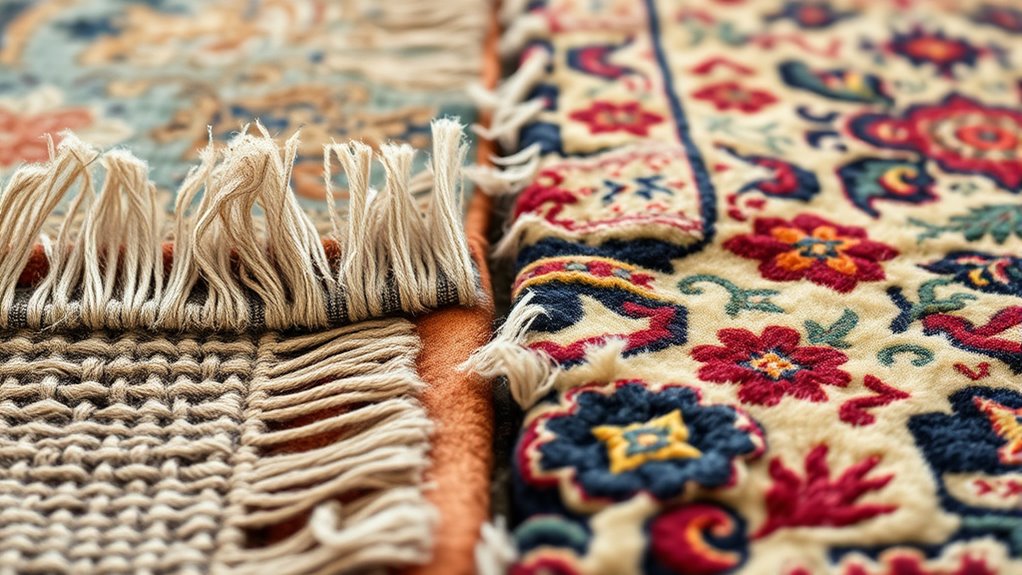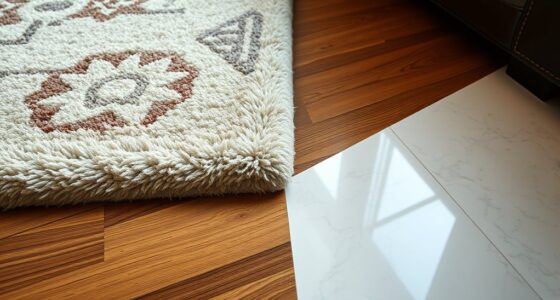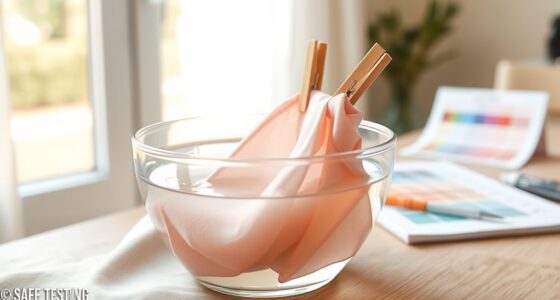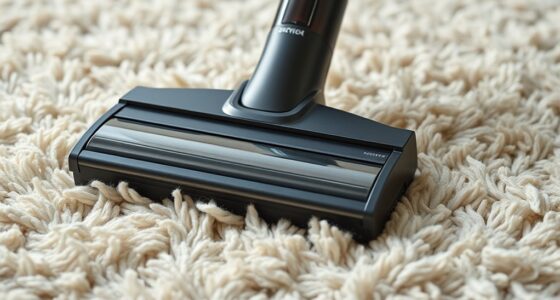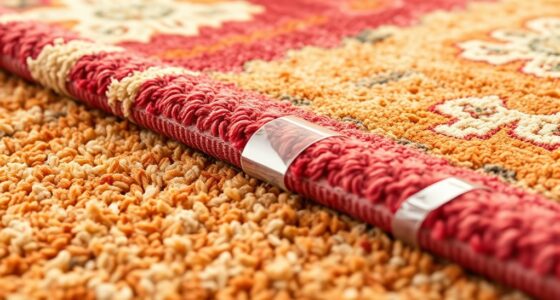When comparing budget and bespoke rug restoration costs, you’ll find that budget options focus on basic repairs, standard dyes, and synthetic padding, which keep prices low but may compromise authenticity and durability. Bespoke restoration, however, uses skilled artisans and high-quality materials, leading to higher upfront expenses but resulting in longer-lasting, more authentic restorations. To better understand how these choices impact your budget and rug’s future, explore further details below.
Key Takeaways
- Budget restoration focuses on essential repairs with standard dyes and synthetic padding, keeping costs low.
- Bespoke restoration involves artisanal craftsmanship, high-quality materials, and precise color matching, resulting in higher expenses.
- Budget solutions may sacrifice authenticity and long-term durability, while bespoke options enhance longevity and preserve original value.
- The cost difference is influenced by the complexity of color matching, material sourcing, and the level of detailing required.
- Choosing between the two depends on budget constraints versus the importance of preserving the rug’s integrity and character.
Factors Influencing Restoration Costs
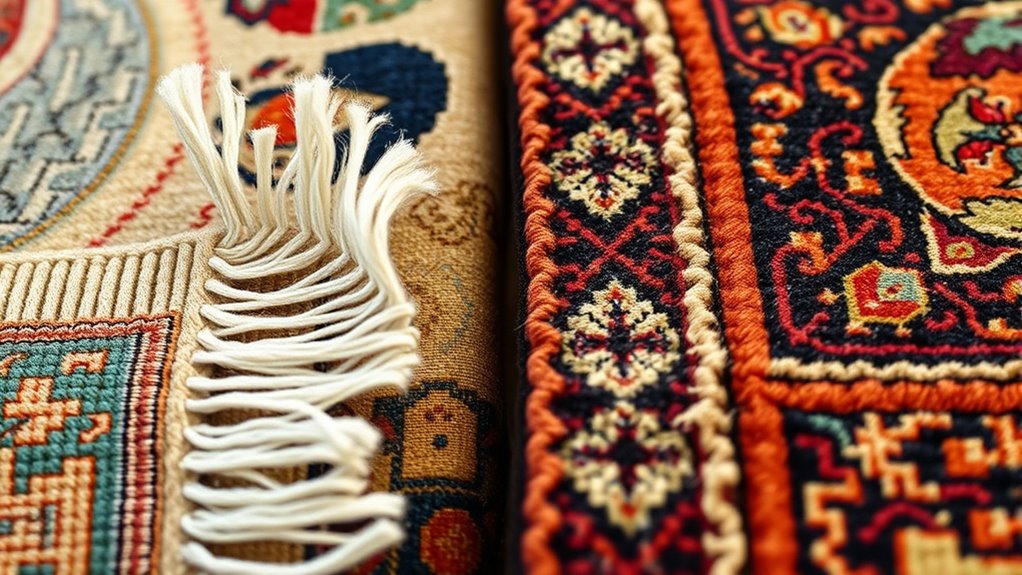
Several key factors directly impact the cost of rug restoration, and understanding them can help you make informed decisions. One major element is color matching, which can be complex if your rug has faded or unique dyes. Precise color matching requires skilled craftsmanship and may increase costs. Additionally, material sourcing plays a vital role; premium or rare materials can drive up expenses, especially if original fibers are hard to find. The quality of these materials affects both the durability and appearance of the restored rug. These factors influence the overall price, as more intricate color matching and high-quality sourcing demand more time and expertise. Moreover, the current trends in rug restoration can also affect pricing, reflecting changes in demand and available techniques. Being aware of these elements helps you gauge the scope and potential expenses involved in restoring your rug, whether you’re on a budget or seeking a bespoke finish.
Components of Budget Rug Restoration Expenses

Budget rug restoration typically involves a focus on essential repairs and basic cleaning, which helps keep costs low. One key component is dye selection, usually opting for standard dyes that provide decent color restoration without the expense of custom shades. This limits the range of hues and may affect the rug’s original vibrancy. Additionally, padding techniques are simplified, often using basic or synthetic padding instead of premium materials, reducing overall expenses. These choices make the process more affordable but may impact the rug’s comfort and durability. Other cost components include labor hours for essential repairs, minimal detailing, and standard cleaning methods. Overall, these components keep budget restoration accessible while addressing the rug’s primary needs. Incorporating color accuracy considerations can help ensure the restored rug maintains a more authentic appearance despite the cost limitations.
Cost Advantages of Bespoke Restoration Solutions
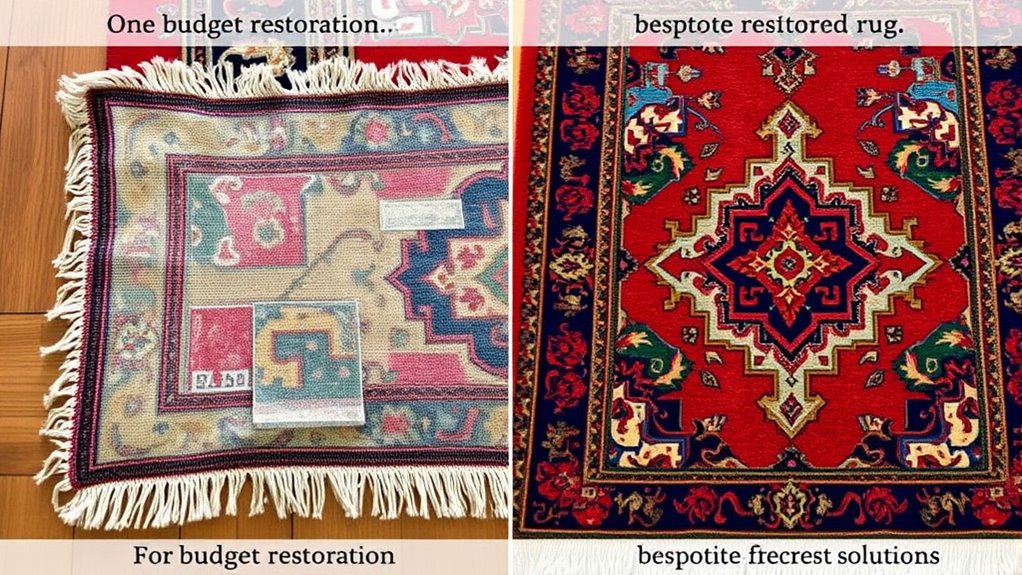
While budget restorations focus on reducing costs by limiting customization, opting for bespoke solutions offers notable financial benefits in the long run. Artisanal craftsmanship guarantees each repair is meticulously executed, reducing the likelihood of future issues that can lead to costly repairs. Additionally, your material selection plays an essential role; choosing high-quality, durable materials tailored to your rug’s needs minimizes the need for repeated restorations. Though upfront costs may be higher, these tailored solutions often prevent premature wear and tear, saving you money over time. By investing in craftsmanship and carefully selected materials, you affirm your rug’s integrity is preserved, ultimately delivering better value and reducing cumulative expenses compared to generic, one-size-fits-all restorations.
Long-Term Value and Durability Considerations
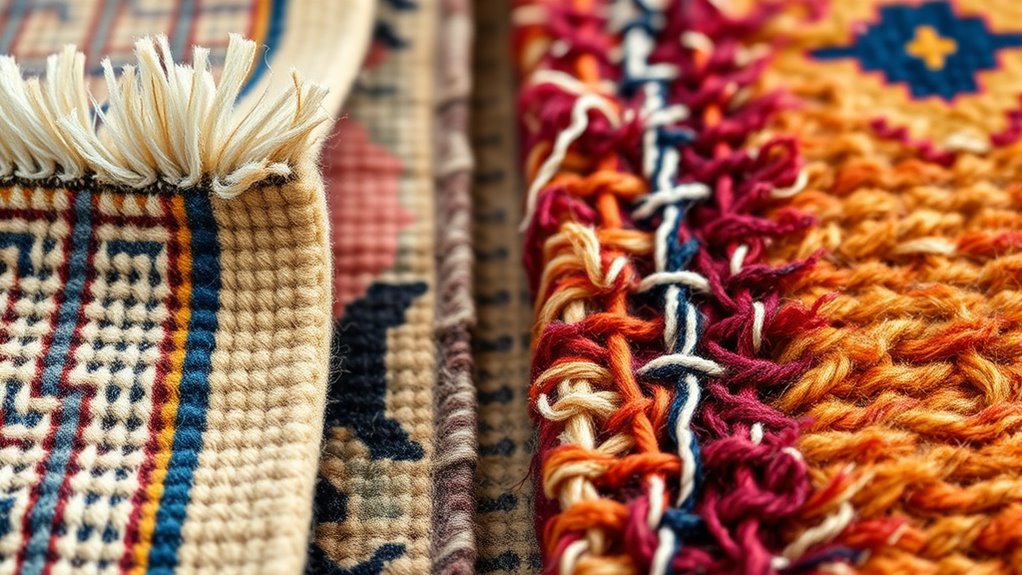
Investing in bespoke rug restoration considerably enhances long-term value and durability because it guarantees repairs are precisely tailored to your rug’s unique structure and materials. Using luxury materials ensures your rug maintains its quality and aesthetic appeal over time. Artisan craftsmanship plays a vital role, as skilled artisans carefully restore delicate fibers and intricate patterns, preventing further damage and preserving authenticity. Unlike quick fixes, bespoke restoration focuses on structural integrity, making your rug more resilient to foot traffic and environmental factors. This meticulous approach results in a durable finish, extending your rug’s lifespan and retaining its value. Over the long run, the investment in craftsmanship and premium materials pays off, offering you a restored piece that stands the test of time while maintaining its beauty. Additionally, understanding rug restoration techniques can help you make more informed decisions about preservation strategies.
Making the Right Choice Based on Your Budget

Choosing between budget-friendly and bespoke rug restoration ultimately depends on what you can afford and your priorities for the piece. If preserving antique authenticity is essential, investing in bespoke restoration ensures expert color matching and attention to detail, maintaining the rug’s historical value. However, if your budget is limited, a budget-friendly approach can still improve appearance but may sacrifice some authenticity and precise color matching. Consider how much you value the rug’s original craftsmanship and whether minor color discrepancies matter to you. Additionally, understanding candle-making techniques can help you appreciate the skill involved in high-quality restoration work. Ultimately, your decision should balance your financial constraints with your desire to preserve the rug’s character. By understanding what each option offers, you can make an informed choice that aligns with both your budget and your appreciation for antique authenticity.
Frequently Asked Questions
How Do I Determine if My Rug Needs Restoration or Replacement?
You should assess your rug’s condition by examining its area rug durability and vintage rug care needs. If it has significant stains, tears, or fading that affect its look and function, restoration might be better. However, if the damage is extensive and repair costs are high, replacing it could be more practical. Consider the rug’s age, sentimental value, and how well it has been maintained to make the best decision.
Are There Eco-Friendly Options Available for Budget Rug Restoration?
In the days of yore, eco-friendly options for budget rug restoration are more accessible than ever. You can choose eco-friendly materials like natural dyes, organic fibers, and biodegradable adhesives. Look for professionals who prioritize sustainable practices, reducing environmental impact. These options help preserve your rug while minimizing your carbon footprint, making restoration not just affordable but also kinder to the planet. Always ask your provider about their eco-friendly methods.
Can Rug Restoration Increase the Resale Value of My Home?
Restoring your rug can boost your home’s resale value by highlighting antique preservation and enhancing material durability. When potential buyers see a well-maintained, restored rug, they notice the care you’ve taken, making your property more appealing. It’s a smart investment that emphasizes quality and longevity, which can lead to higher offers. Proper restoration guarantees your rug remains a beautiful, durable feature, ultimately increasing your home’s overall value and attractiveness to buyers.
What Maintenance Is Required After a Bespoke Restoration?
After a bespoke rug restoration, you should follow proper cleaning protocols to maintain its appearance and longevity. Regular vacuuming helps remove dirt without damaging fibers. Additionally, applying protective treatments can guard against stains and wear. Avoid harsh chemicals and excessive moisture. Routine inspections allow you to spot issues early. These steps ensure your restored rug stays beautiful and preserves its value for years to come, making your investment worthwhile.
How Long Does Each Restoration Process Typically Take?
Ever wonder how long a restoration process takes? The restoration timeline varies depending on the rug’s condition and the complexity of repairs. Typically, a standard process duration ranges from a few days to several weeks. For bespoke restorations, expect a longer process duration due to meticulous craftsmanship. You’ll want to plan accordingly, knowing that quality results often require patience, but the final outcome will be worth the wait.
Conclusion
Choosing between budget and bespoke rug restoration is like picking the right paintbrush for your masterpiece—you want precision, quality, and value. While a budget option might be quick and affordable, a bespoke solution offers long-lasting beauty and craftsmanship. Your choice shapes not just your rug’s appearance but its story for years to come. Weigh the costs carefully, and remember: investing in quality is like planting a seed for a vibrant, enduring garden that only gets better with time.
